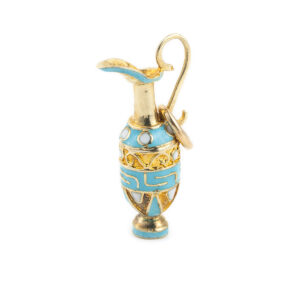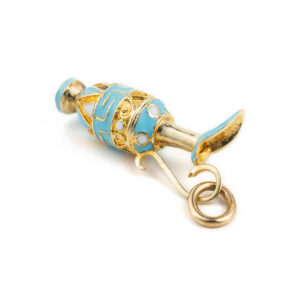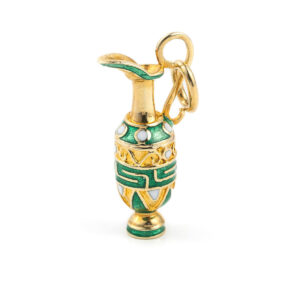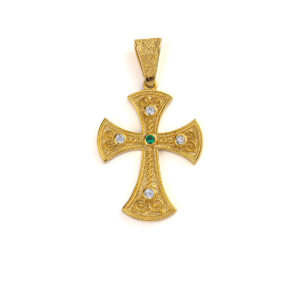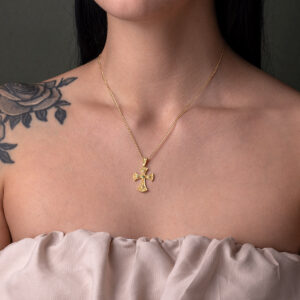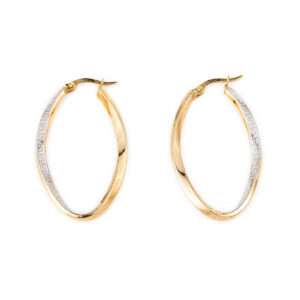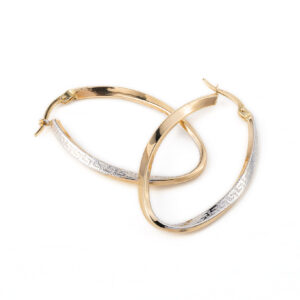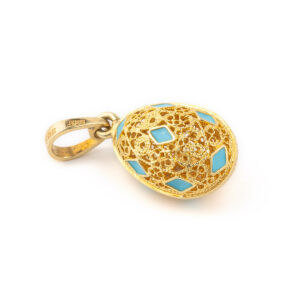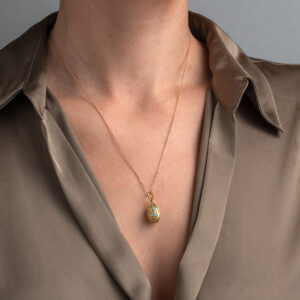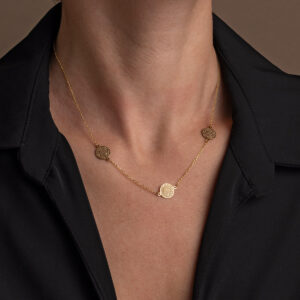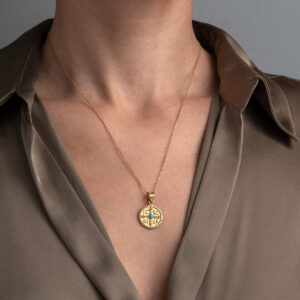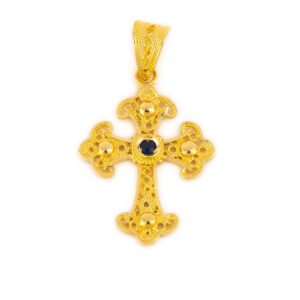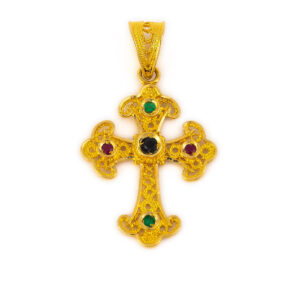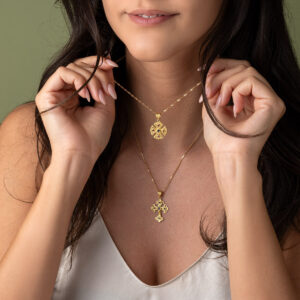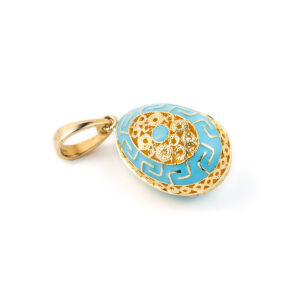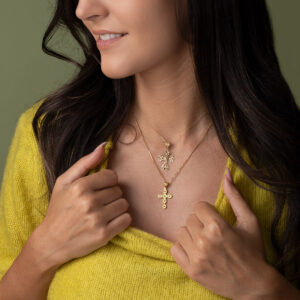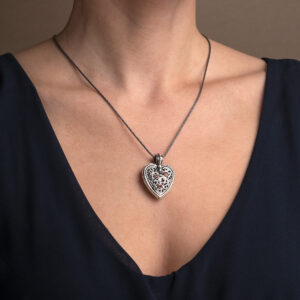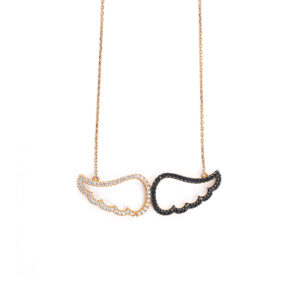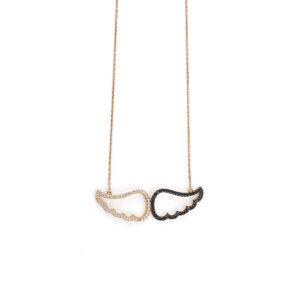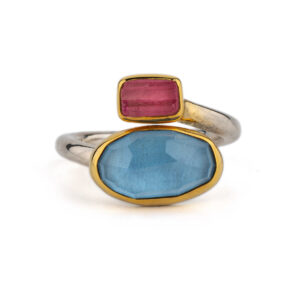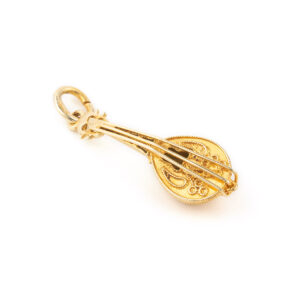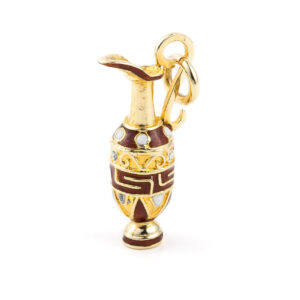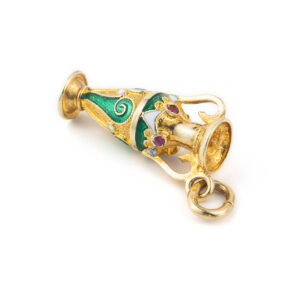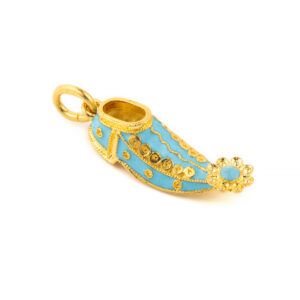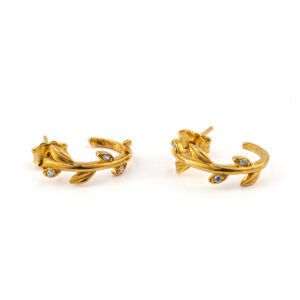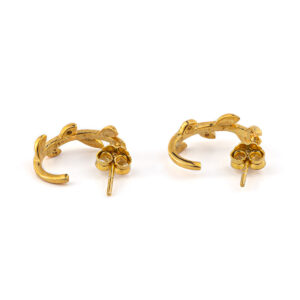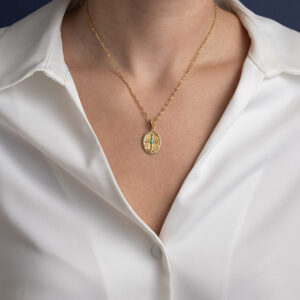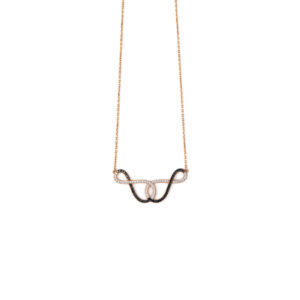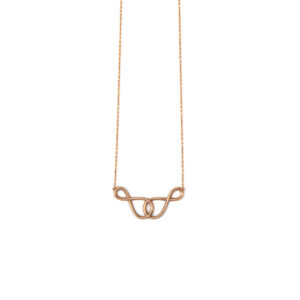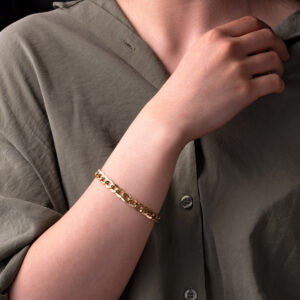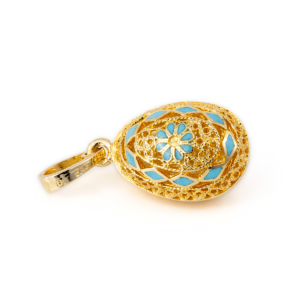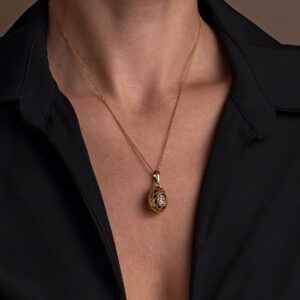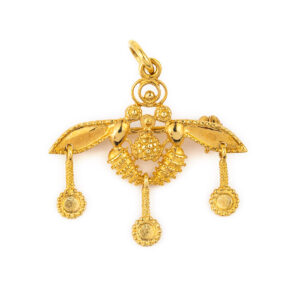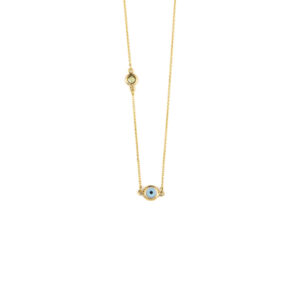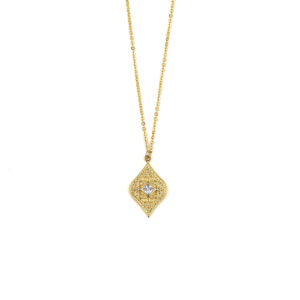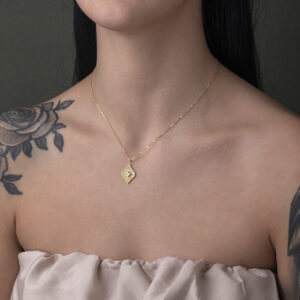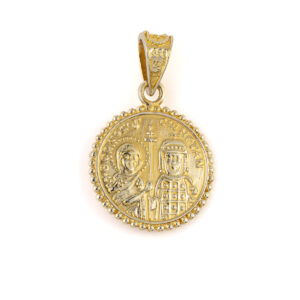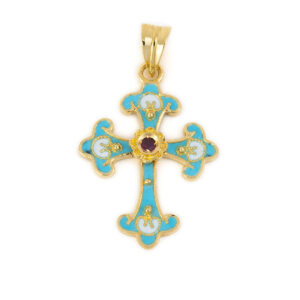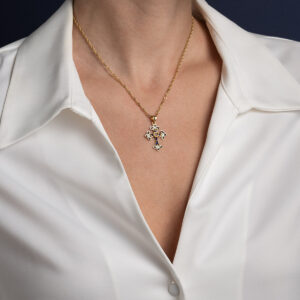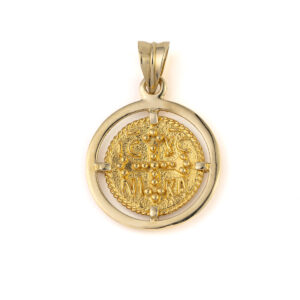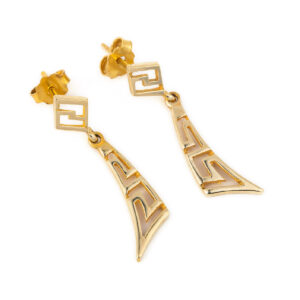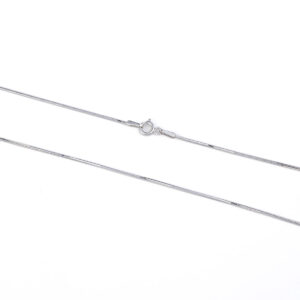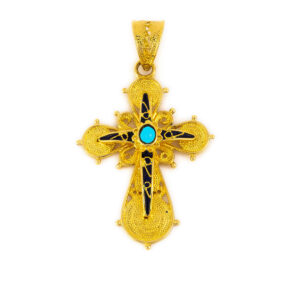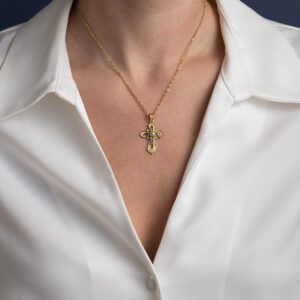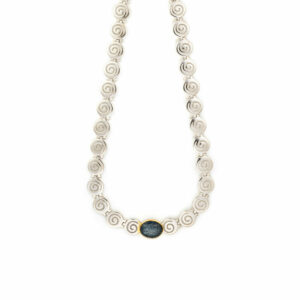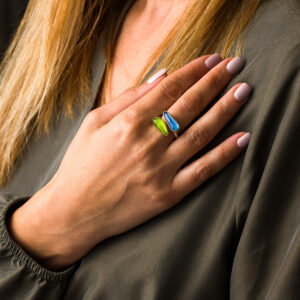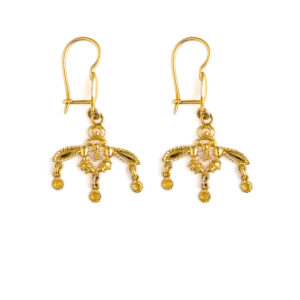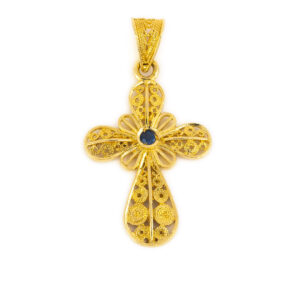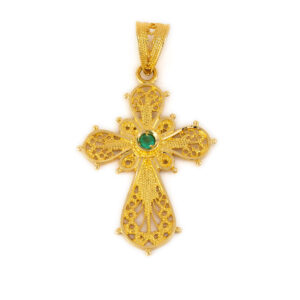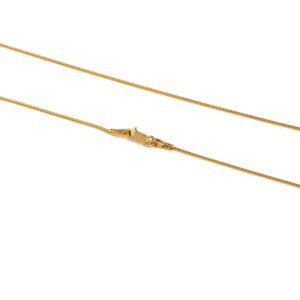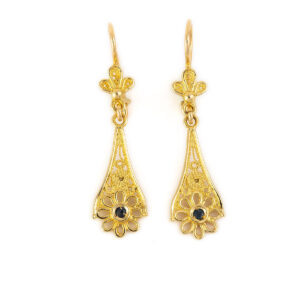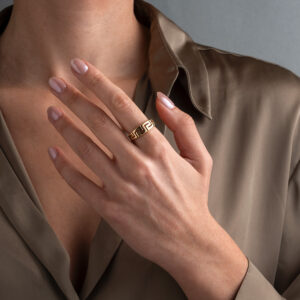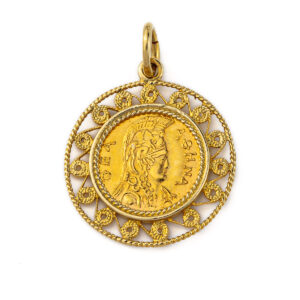Μενταγιόν Αμφορέας – 14Κ Χρυσό
592,00€Ancient Greek Amphora Pendant with Turquoise enamel and Meander design.
Design inspired by the ancient Greek history.
Made in 14k yellow gold
Also available with red or blue enamel
Available in 3 sizes
Handmade item
Amphora is a Greco – Roman word developed in ancient Greek during the Bronze Age. An amphora is a type of container of a characteristic shape and size. Amphorae were used for the transport and storage of various products, both liquid and dry, but mostly for wine. They are most often ceramic. the amphorae used in Ancient Greek vase painting. (source wikipedia)
Meander or Meandros design, one of the most historic symbols of the Greek World, also called Greek Key and symbolizes long life and eternity. The pattern with Meander was used in antiquity to decorate the frieze of temples.
Μενταγιόν Αμφορέας – 14Κ Χρυσό
592,00€Ancient Greek Amphora Pendant with green enamel and Meander design.
Design inspired by the ancient Greek history.
Made in 14k yellow gold
Also available with red or turquoise enamel
Available in 3 sizes
Handmade item
As in all handmade items there may be small differences in weight and dimensions and this is what makes them unique and precious.
Amphora is a Greco – Roman word developed in ancient Greek during the Bronze Age. An amphora is a type of container of a characteristic shape and size. Amphorae were used for the transport and storage of various products, both liquid and dry, but mostly for wine. They are most often ceramic. the amphorae used in Ancient Greek vase painting. (source wikipedia)
Meander or Meandros design, one of the most historic symbols of the Greek World, also called Greek Key and symbolizes long life and eternity. The pattern with Meander was used in antiquity to decorate the frieze of temples.
Μενταγιόν Αμφορέας – 14Κ Χρυσό
592,00€Ancient Greek Amphora Pendant with turquoise enamel.
Design inspired by the ancient Greek history.
Made in 14k yellow gold
Also available with red or green enamel
Handmade item
Amphora is a Greco – Roman word developed in ancient Greek during the Bronze Age. An amphora is a type of container of a characteristic shape and size. Amphorae were used for the transport and storage of various products, both liquid and dry, but mostly for wine. They are most often ceramic. the amphorae used in Ancient Greek vase painting.
Χρυσός Βυζαντινός Σταυρός 14 Καρατίων με Ζιργκόν
598,00€Όμορφος κρεμαστός σταυρός από χρυσό 14Κ.
Χειροποίητο Ελληνικό Κόσμημα
Ανακαλύψτε τη Συλλογή Πίστη
Δίχρωμα Σκουλαρίκια Μαίανδρος – 14Κ Χρυσο
602,00€14k Gold Meander Oval Hoop Earrings
Meandros design is a decorative border constructed from a continuous line, shaped into a repeated motif. Such a design is also called the Greek fret or Greek key design, although these are modern designations. One the one hand, the name “meander” recalls the twisting and turning path of the Meander River in Asia Minor, and on the other hand, as Karl Kerenyi pointed out, “the meander is the figure of a labyrinth in linear form” the meaning is that these is no beginning and to end in some cases so it become the symbol of long life and eternity.
Handmade item.
Δαχτυλίδι Κλαδί – 14Κ Χρυσό με Ζιργκόν
602,00€Ring inspired by the olive leaf symbol.
Made of 14k gold with zircon.
The olive wreath also known as kotinos was the prize for the winner at the ancient Olympic Games. It was an olive branch, of the wild- olive tree that grew at Olympia,intertwined to form a circle or a horse-shoe. According to Pausanias it was introduced by Heracles as a prize for the running race winner to honour his father Zeus. In the ancient Olympic Games there were no gold, silver, or bronze medals. There was only one winner per event, crowned with an olive wreath made of wild-olive leaves from a sacred tree near the temple of Zeus at Olympia. Olive wreaths were given out during the 2004 Summer Olympics in Athens in honor of the ancient tradition, because the games were being held in Greece.
Κολιέ Δίσκος της Φαιστού – Χρυσό 14Κ
605,00€Κατασκευασμένο από 14Κ χρυσό.
Ο Δίσκος της Φαιστού είναι ένας δίσκος από πηλό από το μινωικό παλάτι της Φαιστού στο νησί της Κρήτης. Τώρα, το νησί της Κρήτης είναι μέρος της σύγχρονης Ελλάδας. Ο δίσκος ανακαλύφθηκε το 1908 από τον Ιταλό αρχαιολόγο Luigi Pernier στο μινωικό παλάτι της Φαιστού. Ακόμα και στις μέρες μας η αποκρυπτογράφηση του δεν είναι ξεκάθαρη, καθιστώντας το ένα από τα πιο διάσημα μυστήρια της αρχαιολογίας. Ο δίσκος έχει διάμετρο περίπου 15 εκατοστά και καλύπτεται και στις δύο πλευρές με μια σπείρα από σφραγισμένα σύμβολα. Ο δίσκος διαθέτει 241 μάρκες, που περιλαμβάνουν 45 ξεχωριστά σημάδια, τα οποία φτιάχτηκαν προφανώς πιέζοντας ιερογλυφικές «σφραγίδες» σε ένα δίσκο από μαλακό πηλό, με μια δεξιόστροφη ακολουθία που στρέφεται προς το κέντρο του δίσκου. Αυτό το μοναδικό αντικείμενο εκτίθεται τώρα στο αρχαιολογικό μουσείο Ηρακλείου. Κατασκευασμένο από χρυσό 14 καρατίων.
Χειροποίητο ελληνικό κόσμημα.
Μενταγιόν Κωνσταντινάτο με Τυρκουάζ – 14Κ Χρυσό
605,00€Κατασκευασμένο από Χρυσό 14Κ.
Χειροποίητο Ελληνικό Κόσμημα.
18Κ Χρυσός Σταυρός με Ζαφείρι
609,00€Σταυρός εμπνευσμένος από τη βυζαντινή εποχή.
Κατασκευασμένος από χρυσό 18 Καρατίων.
18Κ Χρυσός Σταυρός με Ημιπολύτιμους Λίθους
609,00€Σταυρός εμπνευσμένος από τη βυζαντινή εποχή.
Κατασκευασμένος από χρυσό 18 Καρατίων.
18k Gold Filigree Byzantine Cross With Sapphire
609,00€Discover the beauty of timeless craftsmanship with this stunning 18k gold Byzantine filigree cross pendant. This handmade piece draws inspiration from the intricate patterns of traditional Byzantine jewelry. The front showcases delicate filigree detailing, while the reverse is polished and unadorned for a classic finish.
Perfect as a religious gift or statement pendant, this handcrafted gold cross celebrates both faith and art. Ideal for those searching for Byzantine gold jewelry, handmade gold crosses, or 18k religious pendants.
Explore Religious Collection
14k Gold Meander Filigree Egg Pendant with Turquoise Enamel
612,00€ – 898,00€The pendant is embellished with a fine filigree and turquoise enamel in Faberge style. Also, the pendant is decorated with a Meander design.
Used as a charm or as a pendant.
Pick up a beautiful gift inspired by the majestic art of Fabergé!
Made in 14k yellow gold
Filigree is a delicate kind of jewellery metalwork, made with tiny beads or twisted threads, or both in combination, soldered together or to the surface of an object of the same metal and arranged in artistic motifs. The art of filigree dates back to ancient history. The first of the found jewelry in this technique has been found in Mesopotamia and dates to thousands of years BC. In the ancient world, particularly in Asia Minor, this art grew at the highest level.
Fabergé egg is a jeweled egg created by the House of Fabergé, in St. Petersburg, Imperial Russia. Virtually all were manufactured under the supervision of Peter Carl Fabergé between 1885 and 1917,[citation needed] the most famous being the 50 “Imperial” eggs, 43 of which survive, made for the Russian Tsars Alexander III and Nicholas II as Easter gifts for their wives and mothers. The first Fabergé egg was crafted for Tsar Alexander III, who had decided to give his wife, Empress Maria Feodorovna, an Easter egg in 1885. Peter Carl Fabergé was a Russian jeweller best known for the famous Fabergé eggs made in the style of genuine Easter eggs, using precious metals and gemstones. He’s the founder of the famous jewelry legacy House of Fabergé. (Wikipedia)
Meander or Meandros design, one of the most historic symbols of the Greek World, also called Greek Key and symbolizes long life and eternity.
14k Gold Byzantine Cross With Multi Stones
615,00€Beautiful Cross Pendant made of 14K Solid Gold.
Handmade in Greece
Explore Religious Collection
Gerochristo – Μενταγιόν Garden Shadows Καρδιά από Χρυσό 18Κ και Ασήμι 925 με Ρουμπίνια
616,00€Μενταγιόν καρδιά, διακοσμημένο με φιλιγκράν, χειροποίητο με ιδιαίτερη προσοχή στη λεπτομέρεια.
Αγκαλιάστε την κομψότητα με το μεσαίο κρεμαστό κόσμημα καρδιάς Garden Shadows από χρυσό 18 καρατίων και ασήμι 925 με ρουμπίνια. Αυτό το εξαίσιο κρεμαστό κόσμημα, που διαθέτει ένα εντυπωσιακό μοτίβο καρδιάς, συμβολίζει την αγάπη και είναι ιδανικό για όσους εκτιμούν τα πιο εκλεπτυσμένα πράγματα στη ζωή.
Το μενταγιόν διαθέτει κομψές λεπτομέρειες, που ενισχύουν τη συνολική γοητεία του.
Ιδανικό για ειδικές περιστάσεις, ως δώρο αγάπης.
Χειροποίητο ελληνικό κόσμημα.
Ανακαλύψτε τη Συλλογή Valentine by Gerochristo
Χρυσό κολιέ φτερά 14K με Ζιργκόν
620,00€Χρυσό κολιέ φτερά 14K με Ζιργκόν
Κολιέ κόσμημα φτερά κατασκευασμένο από ροζ χρυσό 14Κ, διακοσμημένο με λευκές και μαύρες πέτρες ζιργκόν.
Δαχτυλίδι Τουρμαλίνη και Aqua Marine – Χρυσό 18Κ και Ασήμι 925
620,00€Κατασκευασμένο από 18Κ χρυσό και ασήμι 925.
Διακοσμημένο με Aqua Marine και Τουρμαλίνη.
Χειροποίητο ελληνικό κόσμημα.
Όπως σε όλα τα χειροποίητα είδη μπορεί να υπάρχουν μικρές διαφορές σε βάρος και διαστάσεις και αυτό είναι που τα κάνει μοναδικά και πολύτιμα.
14kt Yellow Gold Greek Bouzouki Charm Pendant
620,00€Made in 14k yellow gold.
Handmade in Greece.
Used as a charm or as a pendant.
Design inspired by the Greek tradition
Explore Heritage Collection
History
The Greek bouzouki is a plucked musical instrument of the lute family, called the thabouras or tambouras family. The tambouras existed in ancient Greece as the pandura, and can be found in various sizes and shapes. The bouzouki and the baglamas are the direct descendants. The bouzouki arrived in Greece following the 1919–1922 war in Asia Minor and the subsequent population exchange between Greece and Turkey. The early bouzoukia mostly had three courses. At the end of the 1950s, four-course (tetrachordo) bouzoukia started to gain popularity. The four-course bouzouki was made popular by Manolis Chiotis. Manolis Chiotis was a Greek rebetiko and laiko composer, singer, and bouzouki player. He is considered one of the greatest bouzouki soloists of all time.
Μενταγιόν Αμφορέας – 14Κ Χρυσό
620,00€Ancient Greek Amphora Pendant with red enamel and Meander design.
Design inspired by the ancient Greek history.
Made in 14k yellow gold
Also available with turquoise or blue enamel
Available in 3 sizes.
Handmade item.
The chain shown is our 14K Gold Chain (not included).
Amphora is a Greco – Roman word developed in ancient Greek during the Bronze Age. An amphora is a type of container of a characteristic shape and size. Amphorae were used for the transport and storage of various products, both liquid and dry, but mostly for wine. They are most often ceramic. the amphorae used in Ancient Greek vase painting. (source wikipedia)
Meander or Meandros design, one of the most historic symbols of the Greek World, also called Greek Key and symbolizes long life and eternity. The pattern with Meander was used in antiquity to decorate the frieze of temples.
Μενταγιόν Αμφορέας – 14Κ Χρυσό
620,00€Ancient Greek Amphora Pendant with green enamel.
Design inspired by the ancient Greek history.
Made in 14k yellow gold
Also available with red or turquoise enamel
Handmade item
Amphora is a Greco – Roman word developed in ancient Greek during the Bronze Age. An amphora is a type of container of a characteristic shape and size. Amphorae were used for the transport and storage of various products, both liquid and dry, but mostly for wine. They are most often ceramic. the amphorae used in Ancient Greek vase painting. (source wikipedia)
Μενταγιόν Τσαρούχι – 14Κ Χρυσό
620,00€Have you witnessed the changing of the guards in Syntagma square? This is the most traditional shoe of Greece (tsarouhi). The pendant is decorated with turquoise enamel and rosette motif. The rosette (rose) is a timeless jewel, symbol and amulet. The origin of the term is the Greek word for rose – rodon (ρόδον). Its use began in the Mycenaean era and continues as far as the 2nd millennia BC. The Mycenaean Rosette is a motif that was widespread throughout Mesopotamia, Egypt, Greece and other ancient civilizations. Rosette or Rodax was probably the most popular and favorite decorative element in Mycenaean era, classical antiquity and Byzantine times.
Made in 14k yellow gold.
Used as a charm or as a pendant.
Design inspired by the Greek tradition
A tsarouchi (τσαρούχι) is a type of shoe, which is typically known nowadays as part of the traditional uniform worn by the Evzones of the Greek Presidential Guard. Their origin goes back to the Byzantine times. Originally, various types of similar shoes were worn all over the Balkans, but tsarouchia are mainly associated with the Greeks. They were the most common footwear worn by both urban and rural Greeks, mainly men, but also many women. After the Greek independence in early 19th century, their use was limited to isolated rural areas and nomadic populations. Tsarouciia provide a clear link with the origin of the Evzone uniform in the traditional Greek costume, and with the fact that Evzones were largely enlisted from rural mountainous regions of Greece. Nowadays they are almost exclusively used by the presidential guard and in various traditional festivals and dances along with other traditional Greek garments.(source wikipedia)
Σκουλαρίκια Κλαδί – 14Κ Χρυσό με Ζιργκόν
620,00€Earrings inspired by the olive leaf symbol.
Made of 14k gold with zircon.
The olive wreath also known as kotinos was the prize for the winner at the ancient Olympic Games. It was an olive branch, of the wild- olive tree that grew at Olympia,intertwined to form a circle or a horse-shoe. According to Pausanias it was introduced by Heracles as a prize for the running race winner to honour his father Zeus. In the ancient Olympic Games there were no gold, silver, or bronze medals. There was only one winner per event, crowned with an olive wreath made of wild-olive leaves from a sacred tree near the temple of Zeus at Olympia. Olive wreaths were given out during the 2004 Summer Olympics in Athens in honor of the ancient tradition, because the games were being held in Greece.
Μενταγιόν Κωνσταντινάτο Οβάλ με Τυρκουάζ – 14Κ Χρυσό
624,00€Κατασκευασμένο από Χρυσό 14Κ.
Χειροποίητο Ελληνικό Κόσμημα.
Βυζαντινός Σταυρός – 18Κ Χρυσό
628,00€Byzantine Cross embellished with a fine filigree.
Handmade with the great attention to detail. Inspired by Byzantine art.
Made in 18k gold
Filigree is a delicate kind of jewellery metalwork, made with tiny beads or twisted threads, or both in combination, soldered together or to the surface of an object of the same metal and arranged in artistic motifs. The art of filigree dates back to ancient history. The first of the found jewelry in this technique have been found in Mesopotamia and dates to thousands of years BC. In the ancient world and particularly in Asia Minor, this art grew were at the highest level.
Κολιέ Μάτι με Ζιργκόν – Χρυσό 14Κ
640,00€Κατασκευασμένο από χρυσό 9Κ.
Το σύμβολο και η δεισιδαιμονία του κακού ματιού είναι μία από τις ισχυρότερες συμβολικές εικόνες στον κόσμο. Τα πρώτα γνωστά στοιχεία για την πίστη στο μάτι ανάγονται στην αρχαία Ελλάδα και τη Ρώμη. Υποτίθεται ότι προστατεύει όποιον το φοράει και διάφοροι πολιτισμοί πιστεύουν σε αυτό. Ωστόσο στην Ελλάδα είναι μπλε γιατί εκείνη την εποχή τα μπλε μάτια δεν ήταν τόσο συνηθισμένα και θεωρούνταν ότι έδιναν το “κακό μάτι”.
Χειροποίητο ελληνικό κόσμημα.
Μενταγιόν Αυγό με Ροζέτα – Χρυσό 14Κ και Τυρκουάζ Σμάλτο
642,00€Κατασκευασμένο από Χρυσό 14Κ.
Χειροποίητο Ελληνικό κόσμημα.
Μενταγιόν Μινωική Μέλισσα – 14Κ Χρυσό
642,00€Greek Ancient Minoan Bees Pendant In 14k Gold. The Malia honeybee pendant was discovered at Chryssolakkos, of the Minoan Palace of Malia on the island of Crete, and is thought to date to c.1800 BC. The named Chryssolakkos that means the “pit of gold” because of the precious objects that the farmers used to find there. The Minoan Palace is situated 3 km east of Malia town and is the third most significant known Minoan Palace after Knossos and Phaistos.
This pendant is in the shape of two bees, or wasps, storing away a drop of honey in a comb.
Made in 14k yellow gold
Handmade item.
Κολιέ με Μάτι Κυκλικό – 14Κ Χρυσό
642,00€Φτιαγμένο από χρυσό 14Κ.
Χειροποίητο κόσμημα.
The symbol and superstition of the evil eye is one of the strongest symbolic images in the world. The earliest known evidence for belief in the evil eye goes back to ancient Greece and Rome. It is supposed to wear off evil to anyone who wears it.
Μενταγιόν Κωνσταντινάτο με μπλε Σμάλτο – 14Κ Χρυσό
654,00€Κατασκευασμένο από Χρυσό 14Κ.
Χειροποίητο Ελληνικό Κόσμημα.
18Κ Χρυσός Βυζαντινός Σταυρός με Σμάλτο και Ρουμπίνι
655,00€Σταυρός εμπνευσμένος από τη βυζαντινή εποχή.
Κατασκευασμένος από χρυσό 18 Καρατίων.
Μενταγιόν Κωνσταντινάτο – 14Κ Χρυσό
665,00€Κατασκευασμένο από Χρυσό 14Κ.
Χειροποίητο Ελληνικό Κόσμημα.
Σκουλαρίκια Μαίανδρος – 14Κ Χρυσο
665,00€Gold Geometrical Meander Earrings.
Meandros design is a decorative border constructed from a continuous line, shaped into a repeated motif. Such a design is also called the Greek fret or Greek key design, although these are modern designations. One the one hand, the name “meander” recalls the twisting and turning path of the Meander River in Asia Minor, and on the other hand, as Karl Kerenyi pointed out, “the meaning is that these is no beginning and to end end in some cases so it become thwe symbol of long life and eternity.
Handmade item.
14Κ Λευκόχρυση Αλυσίδα Snake – 45 cm
668,00€Κατασκευασμένη από 14Κ χρυσό.
Χειροποίητο Ελληνικό κόσμημα.
18Κ Χρυσός Σταυρός με Μπλε Σμάλτο
672,00€Σταυρός εμπνευσμένος από τη βυζαντινή εποχή.
Κατασκευασμένος από χρυσό 18 Καρατίων.
Κολιέ Σπείρα με Λάπις Λαζούλι – Χρυσό 14 Καρατίων και Ασήμι 925
Κολιέ με Λάπις Λαζούλι σε ασήμι και χρυσό Κ14. Για μοναδικές εμφανίσεις γεμάτες χρώμα! Κάθε κόσμημα της σειράς είναι μοναδικό.
Δαχτυλίδι Μπλε Τοπάζι και Περίδοτο – Χρυσό 14Κ και Ασήμι 925
680,00€Κατασκευασμένο από 14Κ χρυσό και ασήμι 925. Διακοσμημένο με μπλε τοπάζι και περίδοτο. Χειροποίητο ελληνικό κόσμημα. Όπως σε όλα τα χειροποίητα είδη μπορεί να υπάρχουν μικρές διαφορές σε βάρος και διαστάσεις και αυτό είναι που τα κάνει μοναδικά και πολύτιμα.
Δαχτυλίδι Κλαδί – 18Κ Χρυσό
680,00€Ring inspired by the olive leaf symbol.
Made of 18k gold.
The olive wreath also known as kotinos was the prize for the winner at the ancient Olympic Games. It was an olive branch, of the wild- olive tree that grew at Olympia,intertwined to form a circle or a horse-shoe. According to Pausanias it was introduced by Heracles as a prize for the running race winner to honour his father Zeus. In the ancient Olympic Games there were no gold, silver, or bronze medals. There was only one winner per event, crowned with an olive wreath made of wild-olive leaves from a sacred tree near the temple of Zeus at Olympia. Olive wreaths were given out during the 2004 Summer Olympics in Athens in honor of the ancient tradition, because the games were being held in Greece.
Minoan Malia Bees Dangle Earrings – 14K Solid Yellow Gold
684,00€Dangle earrings inspired by the ancient Minoan Greek Malia bees pendant.
Made of 14K Gold.
Handmade item.
The Minoan Bees Pendant, one of the most famous Minoan artworks, was discovered in the Old Palace cemetery at Chrysolakkos, outside the palace of Malia, the third largest and most significant known Minoan palace after Knossos and Phaistos. Chryssolakkos means the “Pit of gold” because of the many precious objects that were found there. The famous pendant dates back to the Bronze Age, (1800 BC) and it’s an stunning, very detailed representation of two bees or wasps storing away a drop of honey to their honeycomb. This pendant is one of the most famous exhibits in the wonderfully Heraklion archeological museum.
As in all handmade items there may be small differences in weight and dimensions and this is what makes them unique and precious.
18Κ Χρυσός Βυζαντινός Σταυρός με Ζαφείρι
689,00€Σταυρός εμπνευσμένος από τη βυζαντινή εποχή.
Κατασκευασμένος από χρυσό 18 Καρατίων.
18Κ Χρυσός Σταυρός με Ημιπολύτιμους Λίθους
689,00€Σταυρός εμπνευσμένος από τη βυζαντινή εποχή.
Κατασκευασμένος από χρυσό 18 Καρατίων.
Βυζαντινά Σκουλαρίκια με Ζαφείρι- Χρυσός 18Κ
705,00€Βυζαντινά σκουλαρίκια διακοσμημένα με ένα λεπτό φιλιγκράν και με πολύτιμο λίθο ζαφείρι στη μέση.
Χειροποίητο ελληνικό κόσμημα με μεγάλη προσοχή στη λεπτομέρεια.
Εμπνευσμένα από τη βυζαντινή τέχνη.
Κατασκευασμένα από χρυσό 18 καρατίων
Το φιλιγκράν είναι ένα λεπτεπίλεπτο είδος μεταλλικής κοσμηματοποιίας, κατασκευασμένο με μικροσκοπικές χάντρες ή στριφτά νήματα, ή και τα δύο σε συνδυασμό, συγκολλημένα μεταξύ τους ή στην επιφάνεια ενός αντικειμένου από το ίδιο μέταλλο και τοποθετημένα σε καλλιτεχνικά μοτίβα. Η τέχνη του φιλιγκράν χρονολογείται από την αρχαία ιστορία. Τα πρώτα από τα κοσμήματα που βρέθηκαν με αυτή την τεχνική έχουν βρεθεί στη Μεσοποταμία και χρονολογούνται χιλιάδες χρόνια π.Χ. Στον αρχαίο κόσμο και ιδιαίτερα στη Μικρά Ασία, η τέχνη αυτή αναπτύχθηκε ήταν στο υψηλότερο επίπεδο.
Δαχτυλίδι Μαίανδρος – 14Κ Χρυσό
708,00€Ring inspired by the ancient Greek design the Meander or Greek Key.
Made of 14K gold
Meandros design is a decorative border constructed from a continuous line, shaped into a repeated motif. Such a design is also called the Greek fret or Greek key design, although these are modern designations. One the one hand, the name “meander” recalls the twisting and turning path of the Meander River in Asia Minor, and on the other hand, as Karl Kerenyi pointed out, “the meander is the figure of a labyrinth in linear form” the meaning is that these is no beginning and to end in some cases so it become the symbol of long life and eternity.
As in all handmade items there may be small differences in weight and dimensions and this is what makes them unique and precious.
Μενταγιόν Filigree Θεά Αθηνά – Χρυσό 14Κ
708,00€This coins illustrate the portrait of Goddess Athena on the one side and the wisdom owl on the other.
Α beautiful and timeless coin pendant.
Made of 14k gold.
The chain shown is not included.
Goddess Athena and Owl – Athenian silver tetradrachm.
Dracma was the currency used in Greece during several periods in its history. The tetradrachm was an Ancient Greek silver coin equivalent to fourdrachmae in Athens it replaced the earlier “heraldic” type of didrachms and it was in wide circulation from ca. 510 to ca. 38 BC. This coin belongs to the so-called “new style Athenian coins” minted between 166 and 64 B.C. and is considered one of the most popular ancient Greek coins which illustrate the portrait of Goddess Athena on the one side and the wisdom owl on the other. Athena is an ancient Greek goddess associated with wisdom, handicraft, and warfare. Athena was regarded as the patron and protectress of various cities across Greece, particularly the city of Athens, from which she most likely received her name. She’s usually shown in art wearing a helmet and holding a spear. Her major symbols include owls, olive trees, and snakes. Her temples were located atop the fortified Acropolis in the central part of the city. The Parthenon on the Athenian Acropolis is dedicated to her, along with numerous other temples and monuments. Her main festival in Athens was the Panathenaia, which was celebrated in midsummer and was the most important festival on the Athenian calendar. In the classical Olympian pantheon, Athena was regarded as the favorite daughter of Zeus. The owl traditionally accompanies Athena. Because of such association, the owl has been used as a symbol of knowledge and wisdom. The inscriptions contain the city’s “national” appellation (“ΑΘΕ», i.e. “of the Athenians”).As in all handmade items there may be small differences in weight and dimensions and this is what makes them unique and precious.

